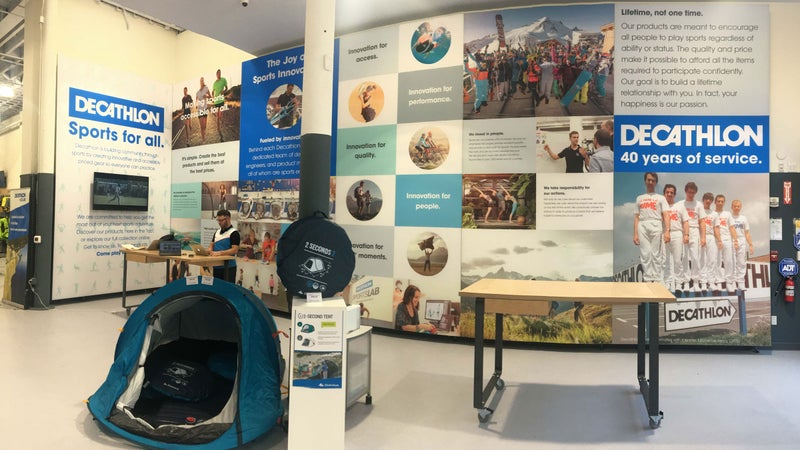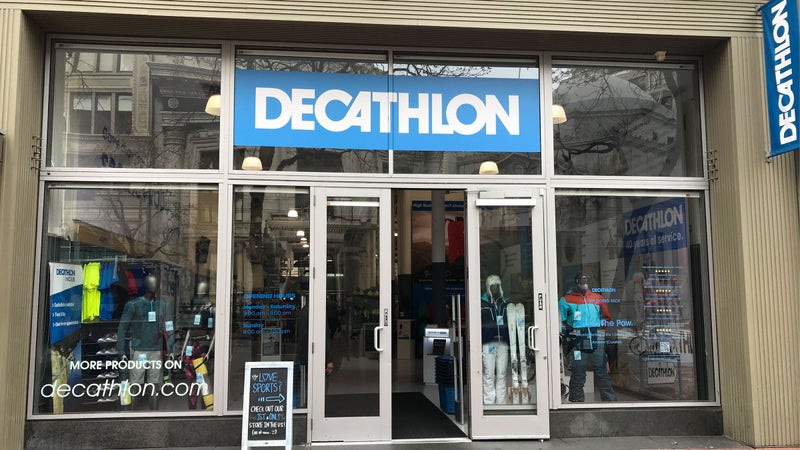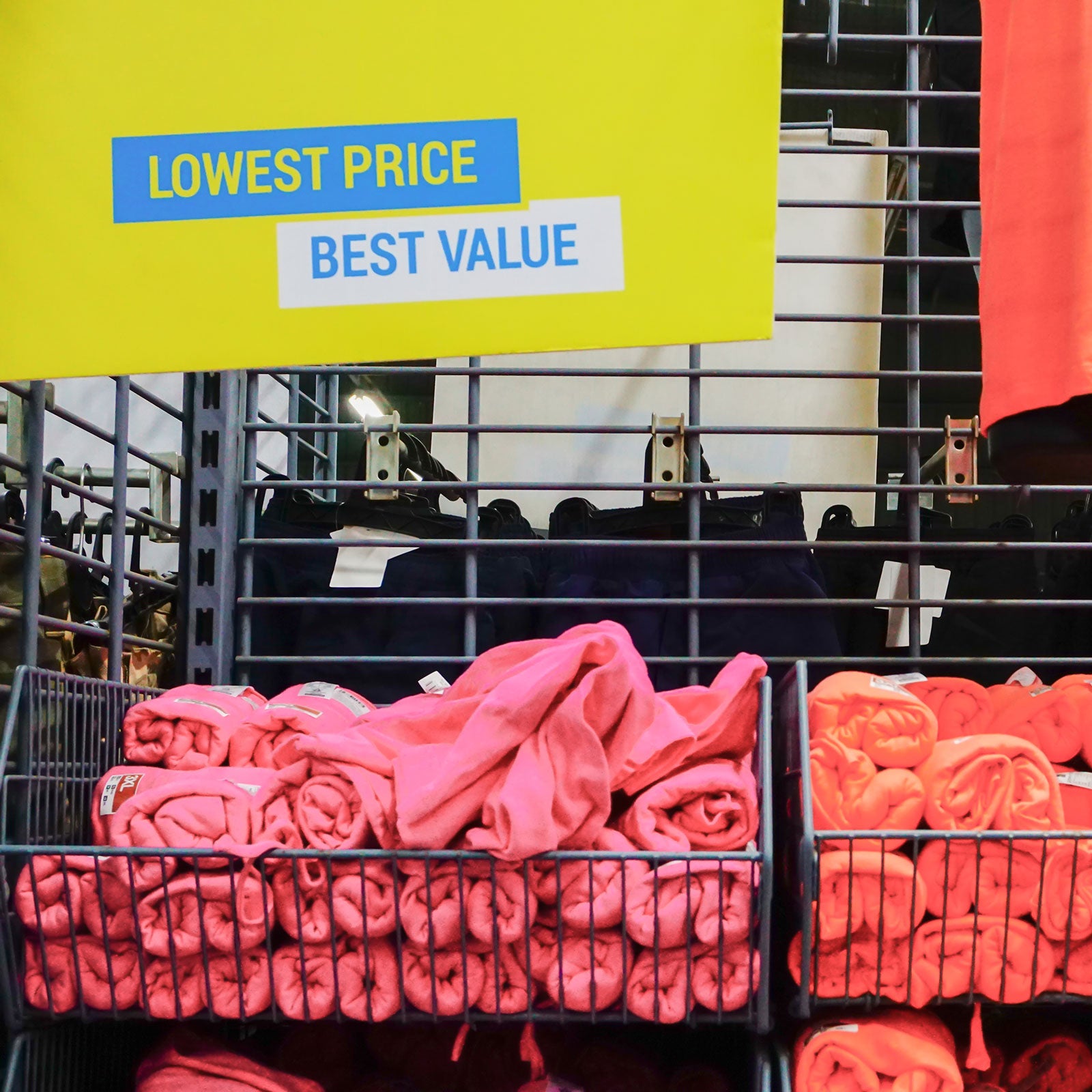A lot of factors add up to your name-brand synthetic down jacket’s $249 price tag.
There are the raw materials, the research and development, and the marketing, of course. But if you’re looking for a comprehensive explanation, says retail analyst Matt Powell, it comes down to a mindset. “The industry is entirely focused on the ‘pinnacle consumer,’” Powell, a vice president at the , says. The jacket’s materials are impossibly packable yet breathable; its prototypes were tested and retested in labs and real-world conditions; maybe someone like Conrad Anker wore the thing on the face of Meru. Add it all up and you get an extremely high-quality down jacket for the cost of a car payment.
That’s what makes walking into such a discombobulating experience.
When I entered the French outdoor retail mega-chain’s downtown San Francisco shop this fall, the first product I saw was a ten-liter backpack, with a few simple pockets and a passing glance at style. Above it, a poster announced the price in large script: . The shock and awe pricing continued: ski poles for $8.95, wetsuits for $16.90, tents for $48.90, down jackets for $57.90. For an American raised in the cult of carbon fiber, a worshiper at the altar of brand-name gear, it was dumbfounding.
Ange Diaz, Decathlon USA’s chief financial officer, has seen this reaction before. In the two decades he’s been with the company, it has conquered markets around the world (including Mexico, Colombia, and Malaysia, ). America is just the latest target. Compact and well dressed for my tour of the inaugural U.S. store, Diaz reacted to my aw-shucks disbelief with Gallic bemusement.
“Some brands in America only focus on the expert sports athlete—that’s their niche,” Diaz said. “So we focus on making sport available and accessible from the beginner to the expert. We try to offer all the range of products.” The company’s tagline: Sports for All, All for Sports.
Although relatively unknown in the U.S., Decathlon is a behemoth overseas. The company has some 1,400 warehouse-size stores in 48 different countries. It sells only its own brands; no North Face or Arc’teryx here. A 700-person-strong R&D department designs products for every sport you can think of—cycling, climbing, badminton, Basque pelota—and releases, on average, a staggering 2,800 new products each year.
But despite the garage-sale prices—actual garage sale, not REI Garage Sale—Diaz recoils when I suggest that the gear is cheap. “People, when they see the product, they are amazed by the price, the value,” he says. But Decathlon, he argues, makes entirely capable gear at a price regular people can afford. “The big thing we are learning is that we have to focus on explaining the value of the product.” Clearly, it’s an approach that has resonated abroad: last year, Decathlon sold more than a billion individual items while generating over $12 billion in sales. In terms of revenue, it’s now more than likely the largest outdoor retailer in the world.
As exciting as cheap stuff is, though, �ٱ��ٳ���Dz�’s beachhead on our shores raises a question: With environmentally conscious buyers increasingly fetishizing gear crafted to last a lifetime and brands like Patagonia priding themselves on , is now the right time for this mass producer of cheap, fast gear to conquer America?
Certainly, the idea that quality gear can be had for cutout-bin prices goes against decades of retail experience for most American buyers.
Simeon Siegel, a senior retail analyst at who covers high-end sporting companies such as Nike and Under Armour, says that top-tier producers price their gear high for a reason. “That group of companies, they are technical innovators of products,” he says. “But at the same time, they are among the strongest marketers in the world.” The high-end companies, Siegel says, allocates an average of 10 to 12 percent of their revenue for marketing, while a typical apparel company spends perhaps 3 to 6 percent. “They pioneered the use of the influencer—they just called them athletes,” he continues. “They pay endorsers a lot of money to create a halo around the brand and help get customers to believe that the technical innovation behind these products will actually make you jump higher, play better, and run longer.”

Decathlon, unsurprisingly, doesn’t do influencers or splashy ad campaigns. Its stores, in the words of its CFO, are “not luxurious.” The San Francisco shop is fluorescent and lined with cheap shelving; the shopping experience feels more Payless than Patagonia. Elsewhere in the world, Decathlon is frequently compared to Aldi, the discount supermarket chain that sells eyebrow-raisingly cheap groceries. (One Yelp reviewer, commenting on �ٱ��ٳ���Dz�’s San Francisco store, wrote “think REI meets Trader Joe’s.”)
When I ask Powell about how REI, Dick’s Sporting Goods, and other presumed competitors in the U.S. market will react to �ٱ��ٳ���Dz�’s presence here, he corrects me. �ٱ��ٳ���Dz�’s real competitors, he says, are Target and Walmart—where most consumers buy their gear. “I’ve been hammering the industry about this for some time. They keep making the products for the pinnacle consumer when the good-enough, everyday consumer is where the money is,” he says. “Ignoring that market is unwise. Some people look down their noses, but family camping is a huge business, car camping is a huge business. Not everybody is interested in doing a three-week hike-in.”
And just because �ٱ��ٳ���Dz�’s products are priced to move, that doesn’t necessarily mean that the quality is suspect. “You can make a sneaker that costs $10 wholesale—that’s not hard to do,” Powell says. “If you go to Walmart, you’ll find $20 shoes.” But instead of marking up the cost of each pair dramatically, Decathlon aims to make its money by selling millions and millions of cheaper shoes at smaller profit margins. Surfing over to �ٱ��ٳ���Dz�’s website, I see that, 80 years after founded REI on the idea of selling reasonably priced ice axes, Decathlon sells one for 47 percent less than REI’s lowest-priced model.
At the San Francisco shop, near a filth-strewn block of Market Street, Diaz and a couple of press people lead me through the company’s product line. Decathlon sells gear and clothing for 60 different sports in the U.S., including baseball and Ping-Pong. The company has about two dozen house brands, and the gear is separated into tiers. The most affordable tier—the stuff priced to compel beginners to try new sports and to titillate deal hunters—is not designed for performance, Diaz says. The $4 running shirts, for example, he says, will get someone interested in taking up running through a nice short-distance jog; tackle a half marathon in the thing and you might experience some chafing. And the ski pants are designed assuming that the wearer will spend a significant amount of time on his or her ass, and are thus more waterproof (but less breathable) than more expensive models.
The step-up, intermediate level improves material quality, but I wouldn’t mistake �ٱ��ٳ���Dz�’s $9 rash guard for something produced by, say, O’Neil. Then comes the advanced equipment, which is still around 30 percent cheaper than name-brand competitors but has familiar bells and whistles. This stuff, Diaz argues, is directly comparable to what big-name companies produce. The $109 70-liter pack reminds me of the REI Co-op intro-level offerings, if a little heavier. The wildly popular $28.90 full-face snorkel mask, which I later bought for myself online, exceeded my expectations (several strangers asked to try it out during a subsequent trip to SoCal’s Cardiff Reef). The high-end bikes, which start at around $1,100, are “absolute cracker” value for the money, per a .
Indeed, in part due to its disconcertingly low prices—a ski helmet —the company has serious admirers. “Decathlon has a reputation for selling quality bicycles and cycling accessories at very sharp price points,” the UK’s . Hit the trails anywhere in Europe and you’ll be bombarded with Quechua garb—�ٱ��ٳ���Dz�’s in-house mountaineering brand. Even ���ϳԹ���’s own gear team is sold. “We wanted to know whether this startlingly cheap gear was any good, so we got our hands on a sampling of hiking and camping products,” Ariella Gintzler and Emily Reed wrote. “In short, we were pleasantly surprised by how solid everything seemed.”

When I tell Diaz that the prices of some goods are so cheap that they make me question the value of everything in the store, even the high-end stuff, he explains that that’s part of the model. “Sometimes people say, ‘Why don’t you raise the prices so people will understand the quality?’” he says. “But that’s not who we are. At the beginning it’s difficult, we know, but after trying the products, people will continue to buy them. Why buy other products for twice the price?” The customer who comes in for the $6 running shorts, Diaz says, will eventually move their way up to the $27 compression socks and $78 shoes.
But �ٱ��ٳ���Dz�’s bargain prices do come at a cost, critics say.
Although the company talks a big game when it comes to its sourcing and supply chain, promising to put people first and ensure that , some international labor activists disagree. “They are lagging far behind the industry forerunners,” says Paul Roeland, of the , an alliance of garment-industry labor organizations and unions. While Patagonia, for example, has worked to improve human rights at the factories and farms that produce its garments and raw materials—even fessing up publicly when it found wage slavery in its Taiwanese contract factories—Decathlon doesn’t talk much about specifics, activists say.
And although the company doesn’t make it easy to figure out which factories make its goods, when a reporter from the German newspaper Die �ܱ���, she found conditions that didn’t gel with the company’s stated values. Pay was around 150 euros a week—a sum that makes it hard to afford basics like shower gel—laborers lived in single-room, barracks-like lodgings, and legally mandated benefits like sick pay and days off for holidays were not enforced. “That is a recurring theme: nice words, vague promises, but a complete lack of verifiable, transparent information and concrete, enforceable improvements,” Roeland says.
Decathlon disputes that its ethics—laid out in its code of conduct—are toothless. The company contracts with suppliers in 49 countries, all operating under a tapestry of different labor laws, and says each “must comply with all applicable laws, regulations, and general principles related to environment, labour, safety, and human rights.”
“Decathlon regularly audits suppliers’ sites, using both internal and external assessment teams. In our manufacturing centers, we have a team of managers—Sustainable Development in Production Managers—dedicated to ensuring standards are achieved by our suppliers,” the company wrote in a statement to ���ϳԹ���. “These managers are local recruits who understand the country’s culture and languages and are continually working with production teams to improve the tools and methods they use to ensure requirements are met.”
Still, Nayla Ajaltouni of , a French pressure group that’s part of the Clean Clothes Campaign, says that although Decathlon appears to have good intentions, its business model prevents it from paying fair wages to international laborers. “It’s based on minimizing production costs and thus wages—that’s the basis of selling large quantities of cheap garments,” she wrote in an email. This is why companies like H&M, Primark, and other producers of fast fashion will never be labor leaders. “Up to now, we’ve had no improvement of working conditions and salaries in garment-producing countries, because this business model is profitable and decision makers in the company have not decided to change it.”
Decatholon says that it has lofty environmental goals, too, and that it aims to use only sustainable cotton and polyester by 2020. It’s a laudable target, though the company’s 2017 sustainable-development report showed that the company was a long way from reaching its goals, using less than 10 percent sustainable polyester and 55 percent sustainable cotton.
Rather than focus on the price of its products, Decathlon and its employees like to talk about accessibility. “What is the sport you always wanted to try?” . “We’re a gateway into learning new sports, because sports can be so expensive,” Diaz says. And in an era when the outdoor industry has woken to its upper-middle-class whiteness, the point is a good one. “We want people to start sport, to practice sport,” Diaz says. “If we can offer them the product at a lower price, it works for us.”
As my tour of the San Francisco store winds town, Diaz and the PR team walk me through �ٱ��ٳ���Dz�’s expansion plans. The downtown location is just a foothold. The next store, , will be a whopping 47,000 square feet. After a year of operation in the States, talking to consumers and working with local sports clubs, the retail team believes it has a better idea of what Americans want—and how to convince real athletes that Decathlon is worth a shot. “If a person comes in for the $3 backpack and it lasts more than the two weeks they expected, they’ll come back in and look around,” Tom Mulliez, �ٱ��ٳ���Dz�’s head of outreach, told me. “All of a sudden, selling them on a $159 jacket is not all that inconceivable.”
On the way out, as we exchanged pleasantries, Diaz and the team gifted me one of those backpacks with a grin. Go to town on it, they told me, it’s got a ten-year guarantee.


